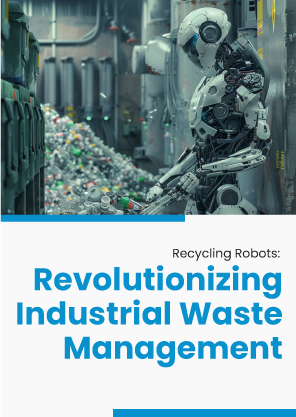or call: +1 (845) 347-8894

or call: +1 (845) 347-8894
or call: +1 (845) 347-8894

Sustainability and efficiency have ascended higher in the list of business concerns than before, and the industrial sector is continuously seeking innovative solutions to manage waste and reduce pollution. One of the most promising advancements in this field is the deployment of recycling robots. These high-tech machines are transforming how industries handle waste, improving sorting accuracy, and boosting recycling rates. This blog explores how recycling robots are revolutionizing industrial waste management and contributing to a more sustainable future.
Above is an image of Daisy, a high-tech robot designed by Apple specifically to disassemble iPhones for recycling purposes. Unlike traditional e-cycling machines that crush devices, Daisy carefully takes apart iPhones to recover valuable materials like gold, tungsten, and other rare earth metals.
Recycling robots have emerged as game-changers in the industrial waste management landscape. Equipped with advanced artificial intelligence (AI) and computer vision technologies, these robots are capable of identifying and sorting various materials with remarkable precision. They can distinguish between different types of plastics, metals, paper, and glass, ensuring that each material is sorted into the appropriate category for recycling.
Recycling robots utilize a combination of sensors, AI algorithms, and robotic arms to perform their tasks. Here’s a breakdown of the process:
Using spectral imaging and near-infrared (NIR) sensors, recycling robots detect the unique signatures of different materials. This technology allows them to accurately identify and differentiate materials, even distinguishing among various types of plastics.
Once identified, robotic arms equipped with grippers or suction cups pick up the items and place them into designated bins. These robots can handle a wide range of items, from small plastic bottles to larger metal pieces, at impressive speeds. Some robots can sort up to 6,000 items per hour (Standard Bots) (HowToRobot).
The integration of recycling robots in industrial processes offers numerous advantages:
Recycling robots significantly enhance the efficiency of waste sorting operations. Their ability to process large volumes of waste quickly and accurately reduces the reliance on manual labor and minimizes errors. This efficiency translates to higher recycling rates and lower operational costs for industries.
By ensuring precise sorting, recycling robots help produce higher-quality recycled materials. This improved quality makes the materials more suitable for reuse in manufacturing, reducing the need for virgin raw materials and lowering the environmental impact of production processes.
Although the initial investment in recycling robots can be significant, the long-term cost savings are substantial. Automation reduces labor costs, and the improved efficiency and quality of recycling processes lead to lower overall expenses. Additionally, industries can benefit from reduced landfill fees and potential revenue from selling high-quality recycled materials.
Recycling robots take over the dangerous and monotonous tasks of waste sorting, reducing the risk of injuries among human workers. This shift not only creates a safer work environment but also allows employees to focus on more complex and less hazardous tasks.
Despite their numerous benefits, recycling robots are not without challenges. The high initial costs and the need for integration into existing waste management systems can be barriers for some industries. Additionally, robots still face difficulties in handling highly diverse and contaminated waste streams.
However, ongoing advancements in AI and robotics are expected to overcome these limitations.
Recycling robots that use AI-based technology can perform work faster and with greater accuracy. One example is at a Caglia Environmental recycling plant in Fresno, California, which deploys EverestLabs’ AI and robot. The facility is reportedly capturing 1,400 cans per day and is ready to capture 32,000 pounds of cans per year or more than 1 million cans annually.
Recently, Amazon announced its backing for an early-stage, female-led San Francisco startup called Glacier that makes next-generation, AI-guided recycling robots. “In order to build a future where new materials can be recycled at scale, we must test options to move these materials through the recycling system,” says Nick Ellis, principal of Amazon’s Climate Pledge Fund.
As technology continues to evolve, recycling robots will become more versatile, cost-effective, and capable of handling a broader range of materials. Future innovations may include enhanced AI algorithms for better material recognition and more sophisticated robotic arms for improved handling of complex waste items.
Recycling robots are poised to play a crucial role in the future of industrial waste management. By improving sorting efficiency, increasing recycling rates, and reducing costs, these advanced machines contribute significantly to sustainability efforts. As industries continue to adopt and integrate recycling robots, we can expect a cleaner, more efficient, and environmentally friendly approach to waste management.
Recycling robots represent a leap forward in our quest for a sustainable future. Their potential to revolutionize waste management makes them a vital component of modern industrial practices, paving the way for a greener planet.
